Poultry Welfare Approach
We care for the poultry we raise. That’s why our comprehensive approach has 13 areas of focus to ensure the health and well-being of our chickens at all steps in the poultry supply chain.
WelfareConnect
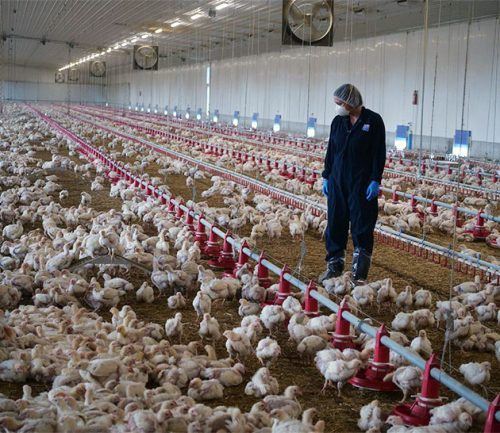
You manage what you measure. Our welfare monitoring program uses frequent audits to measure important indicators of chickens’ well-being
– Our team of trained Animal Health and Welfare Technicians works closely with our hatcheries, farmers, catchers, and transporters through our WelfareConnect program to support best practices in broiler operations supplying Maple Leaf Foods.
– All of our hatcheries and plants use daily third-party Remote Video Auditing (RVA) to support our WelfareConnect program. We plan to pilot Remote Video Auditing with our third-party on-farm chicken catching companies.
– We use our internal and third-party audits and our Remote Video Auditing system to ensure that animal care and handling meets our standards and to support continuous improvement.
– Our farmers are also audited by their provincial poultry boards to ensure compliance with the mandatory Canadian Hatching Egg Producers Animal Care Program and Chicken Farmers of Canada Animal Care Program, which are based on the NFACC Code of Practice for the Care and Handling of Hatching Eggs, Breeders, Chickens, and Turkeys.
– In 2023, our poultry supply chain passed their third-party audits, with scores between 97.34% and 99.27%, based on National Chicken Council standards for broiler chickens. Our owned breeder grower and hatching egg operations achieved 99.6% and all our hatcheries were in compliance with the Canadian Hatchery Federation Animal Care Program.
High welfare genetics
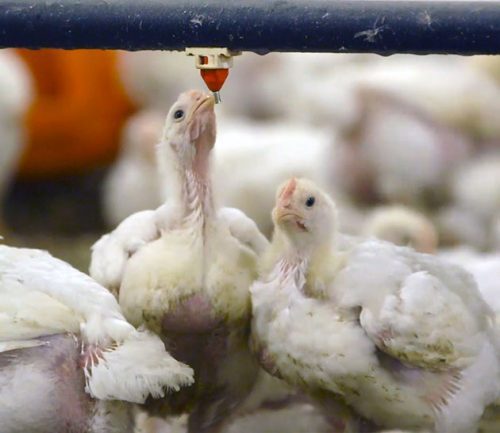
We choose chicken breeds that support good welfare outcomes and balance environmental impacts.
– We participate routinely in chicken breed trials to identify breeds with strong welfare outcomes.
– As part of this effort, we evaluated several slower growing chicken breeds where we assessed behavioural differences using Remote Video Auditing, as well as health, productivity, and environmental sustainability outcomes.
– Improving food security and managing our environmental impact are priorities for Maple Leaf Foods and we consider them when evaluating broiler chicken breeds.
Hatching egg production
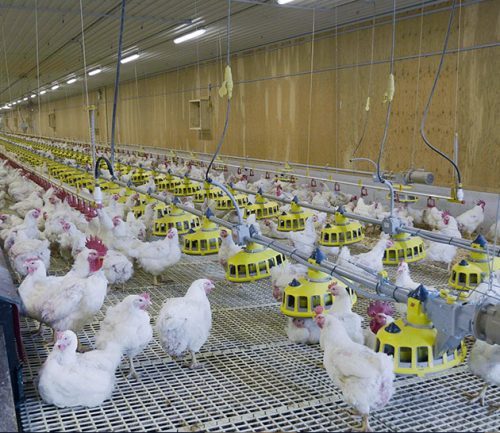
Healthy chicks come from well-cared for hens. We manage the care of our breeding chickens to ensure they produce good quality eggs and strong chicks.
– Our broiler breeder care team assists our hatching egg producers and our staff in implementing leading animal care practices.
– Comprehensive flock monitoring allows us to optimize production of our flocks and respond quickly to health or welfare concerns.
– We provide environmental enrichments to our flocks to encourage natural behaviour and improve leg health in our birds. Our owned breeder grower flocks are provided ramp platform and pecking stone enrichments, which improve feathering and health, and our broiler breeders have ramp platforms which improve leg health.
– Our flocks are monitored through multiple flock checks daily and routine internal, third-party, and provincial poultry board animal welfare auditing.
Hatchery process
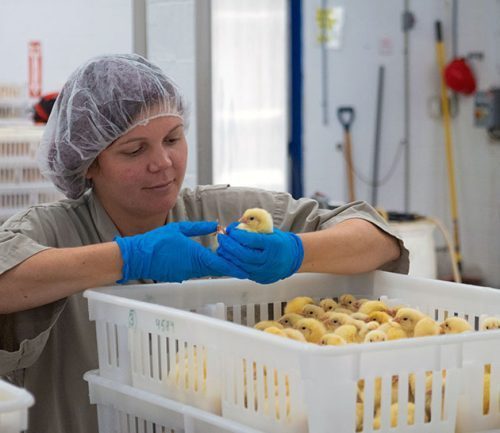
We rely on trained incubation specialists to ensure healthy development and welfare of our eggs and chicks.
– The goal of our process specialists is to match hatchery production with planned sales as closely as possible, while producing healthy, robust chicks.
– We monitor production through daily Remote Video Auditing and frequent quality control and sanitation checks to ensure chick health and welfare.
– We expanded and renovated our Alberta hatchery with best-in-class incubation and chick handling equipment.
– We continually explore new technologies to enhance bird well-being, such as in-hatchery hydration and nutrition.
Enriched living conditions
Our barn enrichments support natural behaviours like hiding, resting, perching, and pecking by providing interactive objects that make a positive impact in a bird’s life.
– Animal welfare includes physical, mental, and behavioural well-being. Welfare is better when animals have positive experiences and can express their instinctive, natural behaviours.
– We conducted robust field testing of multiple broiler environmental enrichment objects in 2019 and 2020 to determine which enrichments are best used by the birds and to measure impacts on animal welfare. We have openly shared our findings and the new science with our farmers and industry partners and are advocating for this science to be incorporated into routine flock management.
– Benefits of enrichments included increased activity and demonstration of natural behaviours, increased leg strength, and reduced footpad dermatitis.
– Based on the demonstrated benefits, we are strongly encouraging our independent broiler farmers to implement enrichments and are providing enrichment objects and on-farm technical support free of charge.
– In 2023, 9% of our total global chicken supply was raised with enrichments, including all farms supplying our Certified Humane® Raised and Handled and Certified Organic programs.
Our broiler enrichment objects:
We developed three broiler environmental enrichment objects following extensive field testing, practical experience, and producer partner feedback. We also partnered with Dr. Martin Zuidhof through the Poultry Innovation Partnership to complete a full statistical analysis of our enrichment testing results, including bird behaviour, footpad and hock lesions, bone strength attributes, and production parameters. Our objects are designed to provide broilers with ideal opportunities to express their natural behaviours, while being easy to clean, bio-secure, lightweight, and safe. All of our Certified Humane® Raised and Handled and Certified Organic farms are equipped with our new enrichments, and we are expanding to other farms in our poultry network.
Grid ramp to promote perching
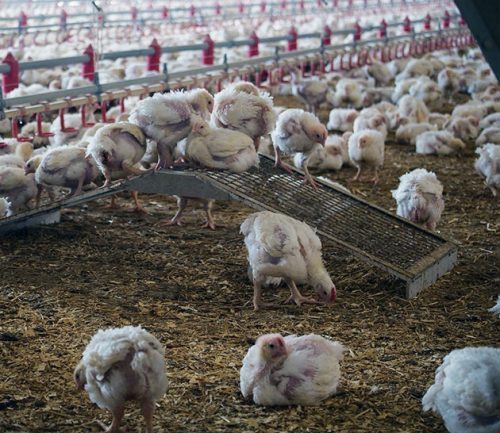
Washers and zip-ties to promote pecking
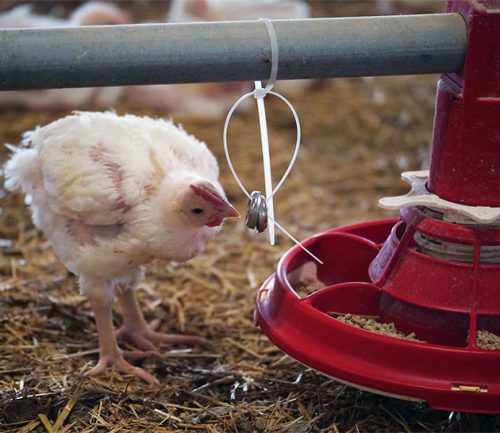
Trapezoid hut to promote hiding and resting
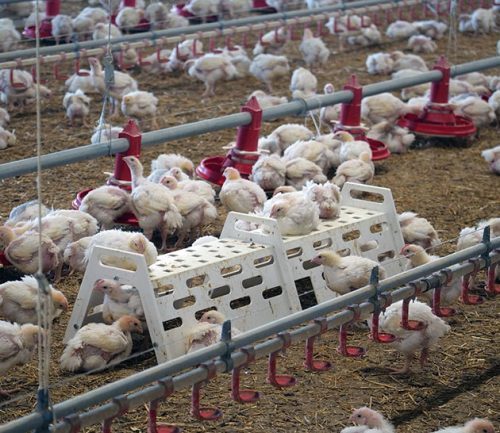
Healthy lighting
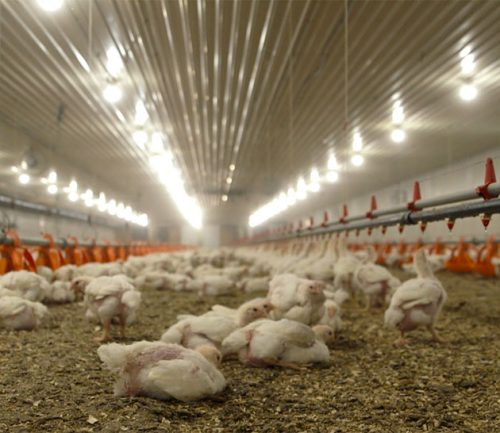
We use lighting programs designed to simulate the natural light and dark conditions chickens would experience outdoors.
– Lighting programs are complex and constantly evolving as new research and technologies become available. We are promoting lighting programs that provide six continuous hours of darkness per 24-hour period and dawn-to-dusk lighting, which are well known to improve bird welfare.
– We are committed to enhancing our lighting programs as new findings emerge related to light intensity, gradient lighting, and light wavelength, and are actively supporting lighting research.
– In 2023, we supported a research trial at the University of Saskatchewan evaluating gradient lighting for broilers to understand the impact on bird health and welfare. Gradient lighting gives chickens the ability to choose the light intensity they are most comfortable in.
How we are supporting broiler lighting research:
We collaborated with Dr. Karen Schwean-Lardner and her team from the University of Saskatchewan to conduct a research trial to understand whether providing broilers with light and dark areas in the barn has an impact on welfare and production. We investigated outcomes including leg and footpad health, bird production measures, behaviour, melatonin concentration and indicators of stress. Under our study conditions, the distribution of light intensity had minimal impacts on bird welfare and productivity. In comparison, previous research suggested that birds preferred to perform certain behaviours under different lighting. Our results indicate that a bird’s location in the barn and its age may influence where it performs certain behaviours.
Space to roam and play
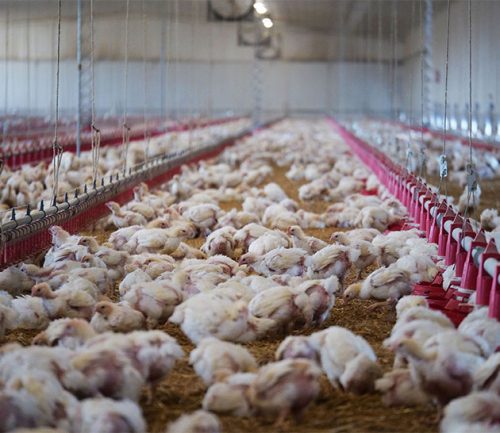
Providing birds sufficient space for comfort and freedom to move is critical for good animal welfare.
– We routinely assess animal well-being indicators to validate stocking density and management outcomes, such as leg condition, footpad health, and behaviour.
– We are actively engaging in research trials to strengthen scientific understanding of stocking density impacts on animal welfare. We promote continuous improvement of the NFACC Code of Practice for the Care and Handling of Hatching Eggs, Breeders, Chickens, and Turkeys based on new and emerging science.
– Stocking density data is reviewed annually with our farmer organizations who are accountable for auditing and verifying that density standards are met. We advocate for transparent reporting of stocking density measurements by farmer organizations.
– In 2023, 70% of the broilers that directly supplied our primary processing operations were housed at 31 kg/m2 or less, meaning each barn maintained a maximum density of 31 kilograms of chickens per square metre of barn floor space.
How we are advancing stocking density understanding:
We collaborated with Dr. Karen Schwean-Lardner and her team from the University of Saskatchewan to conduct a research trial evaluating the impacts of broiler stocking density on bird welfare, performance, environment, and condemnations. We investigated outcomes including leg and footpad health, bird production parameters, indicators of stress, and environmental measures such as air quality and bedding quality. We also evaluated the impacts of stocking density on bird behaviour by analyzing video recordings. The effects of stocking density are very dependent on management of the environment. However, regardless of how well this is controlled, there is evidence of poorer welfare at higher densities, including reductions in production, poorer litter quality, and increases in footpad lesions, infectious mortality, fear, and stress levels. The results of this work have been published in the Journal of Applied Poultry Research and are informing how we and the industry approach broiler stocking density.
Healthy air and litter
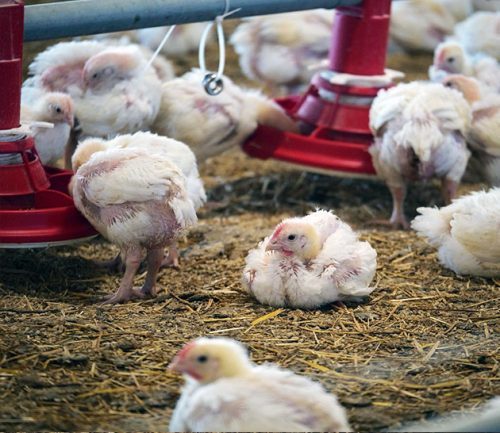
We manage bird litter carefully and monitor air quality because healthy air and litter quality are good for our chickens.
– Our chickens receive fresh bedding for every flock for their health, well-being, and to promote good biosecurity.
– Our barns require frequent litter and air quality monitoring, which is validated during our WelfareConnect assessments.
– Wet litter conditions or ammonia levels exceeding 10 ppm require investigation and corrective actions as appropriate.
– We also monitor our birds for footpad dermatitis, which is a type of skin inflammation that causes lesions on the bottom of the footpad and is mostly attributable to wet litter. We measure footpad dermatitis scores based on the severity of the lesions. Footpad dermatitis and other indicators of litter quality are measured at our processing facilities to aid in identifying and correcting litter management opportunities.
– We are implementing footpad dermatitis scoring of 100% of birds we process to better enable our farmers to make changes to the barn environment when needed. We partnered with Arrowsight to implement an artificial intelligence-based system to measure footpads in our Edmonton facility using Remote Video Auditing. We rely on vision grading systems in our new London facility to measure 100% of footpads.
– In 2023, 61% of broiler chickens supplying our owned processing plants had acceptable footpad health, based on routine auditing.
Humane euthanasia
We seek to raise healthy chickens, but on some rare occasions, we must euthanize a sick or injured bird to prevent suffering. We train and validate our Team Members and farmers to ensure that the practice is carried out properly and promptly to minimize suffering.
– We have stringent protocols for timely euthanasia in all our poultry facilities. Our Team Members and farmers undergo annual, specific, and comprehensive training to perform euthanasia.
– We provide training support and validation for our farmers to ensure they are comfortable performing euthanasia properly.
Training our people
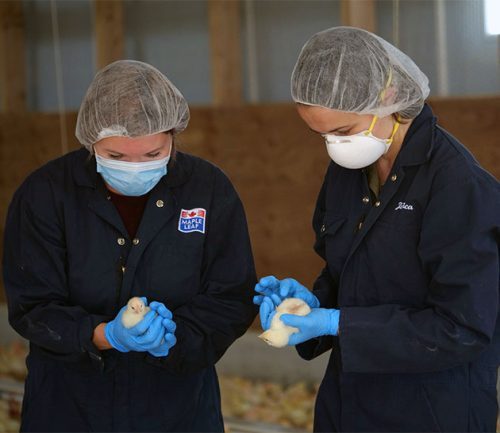
Providing our people with the knowledge and skills to care for animals properly is how we build our culture of care.
– Rigorous, routine animal welfare training is a priority for all Maple Leaf Foods employees who handle or care for poultry. Training is delivered hands-on and through a variety of media.
– We are developing customized video training modules for our poultry operations as part of our comprehensive training approach.
– We are implementing an Animal Care Certification program to assess and certify employees based on demonstrated competencies.
Responsible antibiotic use
We seek to balance antibiotic use to prevent antibiotic resistance while protecting welfare through timely and effective treatment of sick birds.
– We only use antibiotics to prevent or control sickness and never to promote growth.
– Our veterinarians must prescribe antibiotics and choose the most effective medication for birds that is least important to human medicine.
– In Canada, antibiotics are classified into different categories (I, II, III and IV) based on their importance in human medicine. We do not allow preventative use of Category I or II antibiotics or therapeutic use of Category I antibiotics in our broiler chickens and are active supporters of initiatives by Canada’s poultry industry to reduce antibiotic use.
– As part of our efforts to reduce antibiotic use, we started producing Raised Without Antibiotics (RWA) chicken more than 20 years ago and are now Canada’s largest processor of RWA chicken. Chickens marketed as RWA have never received antibiotics of any class for any reason. If RWA chickens become sick, they receive treatment and will no longer be marketed as RWA.
– Consistent with industry standards, any animal that receives an antibiotic follows strict withdrawal times before processing to ensure the medication has cleared the animal’s system.
Low stress transportation
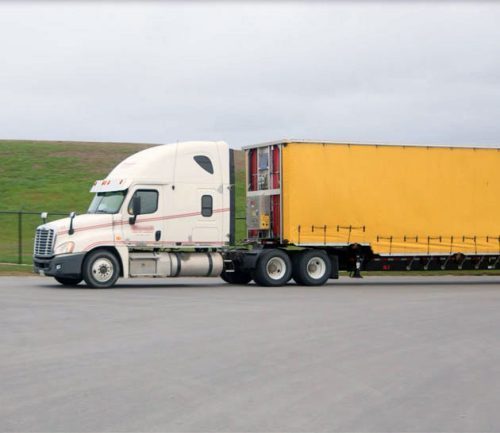
We have invested in climate-controlled trailers and SafeFlight real-time trailer environmental monitoring to keep our birds comfortable and reduce stress during transportation.
– Our Animal Health & Welfare Technicians perform frequent WelfareConnect assessments prior to and during catching and loading to monitor and improve animal welfare practices. We are working to pilot Remote Video Auditing with our third-party on-farm chicken catching companies.
– We developed our SafeFlight system to monitor trailer temperature and humidity in real time, allowing drivers and plant staff to make informed decisions to minimize stress during transportation.
– In Alberta, we use climate-controlled trailers to support the transport of birds when a higher level of care is required.
– Our goal is that every bird we transport arrives safely at our plant. In 2023, our broiler transport livability was 99.86%.
Humane processing
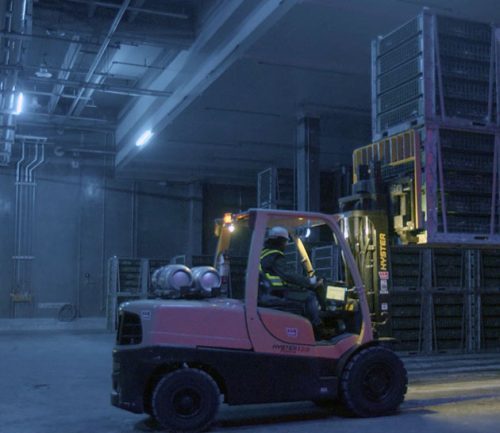
Our processing plants are designed to ensure humane care by using low-stress handling practices and the most effective systems to ensure chickens are insensible before they are handled or processed.
– We have invested in best practice environmentally controlled animal holding areas in our processing facilities to increase bird comfort.
– Our indoor holding areas are quiet, and equipped with lighting that is dimmed and coloured blue, to reduce bird stress.
– We have converted 100% of our chicken plants to the highly regarded Controlled Atmosphere Stunning (CAS) technology that uses an anaesthetic gas to ensure chickens are insensible before they are handled in the plant.
– As of the end of 2023, 100% of chickens we process are stunned using Controlled Atmosphere Stunning.